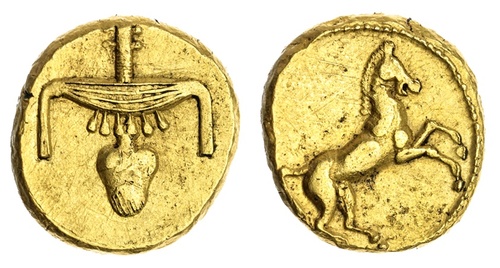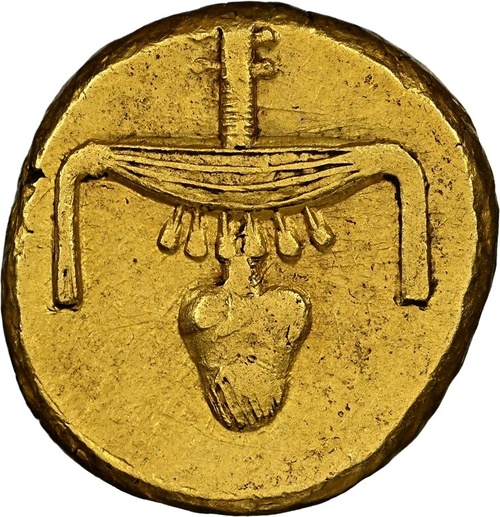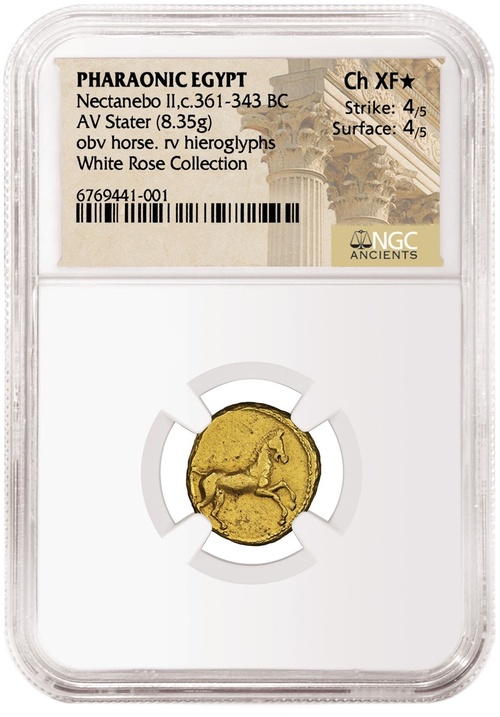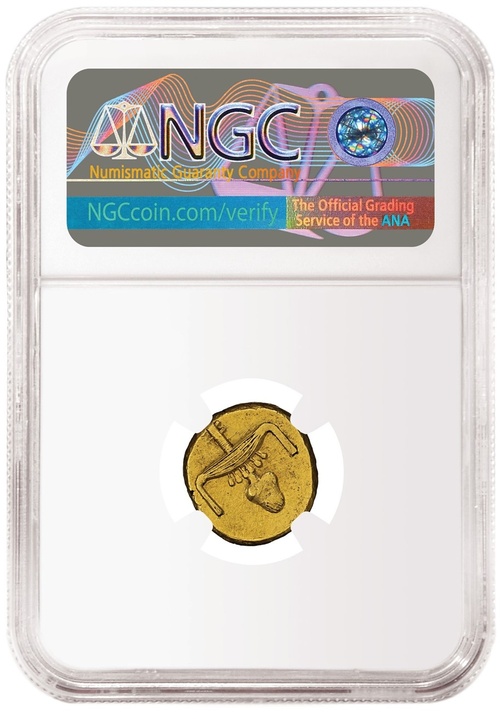Auction: 23004 - Ancient and British Coins - Featuring the 'White Rose' Collection
Lot: 634
NGC Choice XF* | Pharaonic Egypt, Nectanebo II (359-340 BC), 'The King's Good Gold', AV Stater, horse prancing to right, rev. two hieroglyphic signs, a pectoral necklace with six pendant beads ('nebew'='gold') crossing over a heart and windpipe ('nepher'='good'), 8.36g [129.0grns], 2h (Faucher, Fischer-Bossert & Dhennin [2012] dies D1/R2 [and 6e this coin (?)]; SNG Copenhagen 1; SNG Berry 1459; Svoronos 9, var.) struck under the last native Pharaoh of Egypt, Nectanebo II, this is the only known gold coin to have employed hieroglyphs, beautifully-centred, with only scant die softening to highest profiles, sporadic contact marks in otherwise residually lustrous fields still fresh from original mint die 'adjusmtents', a really pleasingly good very, and probably better for issue, OF THE HIGHEST RARITY AND GREATEST NUMISMATIC IMPORTANCE - 'the twilight of Ancient Egypt' - and one of only 48 examples officially documented, with fewer than 20 known from this die pairing, and fewer still available to commerce; this the first fresh example to be offered by these rooms since 1988, in NGC Ancients holder, graded Choice Extremely Fine STAR (Cert. #6769441-001)
Provenance
Probably: Rollin & Feaurdent, by private treaty, 1925/26
~ Mit Rahineh (Winter 1919/1920), Egypt Hoard ~
Chanissat in his 1923 article ('Les trouvailles de monnaies egyptiennes a legendes hieroglyphiques') in the Recueil de Travaux (1923), documented that no fewer than thirty-eight coins had been recovered at Al-Aziziyah, near Mit Rahineh fulfilling a pattern of individual site finds of the type in the region dating back to the 1890s. Joseph Khaouam in communication with Chassinat had studied at least twenty-seven of the new coins and confirmed principally that they were not sophisticated forgeries as had previously been ascribed to the individual finds. Although, as and as G P Hill noted at the time, frustratingly not every coin was illustrated, but from the surviving plate it is clear how many from the trove are double die-linked to the present example. The surfaces of the present specimen are also entirely consistent with those found in the hoard. An example was acquired by the British Museum in 1926, with mention made that at least four examples had passed to well-known French dealers Rollin & Feaurdent, who were active participants in the London numismatic scene in the first decades of the 20th Century.
This remarkable stater, struck on the Macedonian weight standard, is the only 'true' Egyptian gold coin to feature hieroglyphic script. It was struck by Nectanebo II (ca. 361-342 BC), the last native Pharaoh of the 30th Dynasty who opposed the re-incorporation of Egypt into the Achaemenid Persian empire. This coin would be one aspect of Nectanebo's many attempts to consolidate and revive traditional Egyptian culture and religion in the face of Persian invasion, and is therefore one of the only ancient Egyptian coins not to directly imitate Greek or Persian coinage. In his bid to maintain Egyptian independence, he had the support of the powerful Egyptian priesthood and maintained an army of Greek mercenaries. The coin is itself symbolic of Nectanebo's unenviable predicament of being a nationalist leader with a regime propped up by foreign military muscle. While it is generally believed that this gold stater was part of an issue used to pay the Pharaoh's mercenaries, the hieroglyphic reverse type identifying it as "good gold" is likely to have been readable only by Egyptian priestly scribes. The hieroglyphic reverse reflects Nectanebo's presentation of himself as a legitimate native pharaoh defending Egypt against the Persians - only the latest manifestation of the "vile Asiatic" repeatedly mentioned in hieroglyphic texts since the third millennium BC. Nectanebo II and his mercenary army successfully repelled a Persian invasion in 351/0 BC, but he was driven from power when the mercenary leaders turned against him and joined the renewed offensive of Artaxerxes II in 342 BC. One such mercenary general, Mentor of Rhodes had been captured by the Artaxerxes III while assisting an Egyptian-backed revolt against Persian rule, and thereafter deployed to lead the Persian invasion against Egypt. It was this campaign that ultimately ousted Nectanebo II from power and paved the way to full Persian overthrow of the Egyptian kingdom. Nectanebo would spend the rest of his life in exile, and Egypt would never again mint coins with hieroglyphic designs. Evidently more than 'good gold' and the support of the religious establishment was needed to keep native Pharaohs on the throne of the Two Lands, even in the twilight of the Persian empire.
Subject to 20% VAT on Buyer’s Premium. For more information please view Terms and Conditions for Buyers.
Sold for
£180,000
Starting price
£50000













